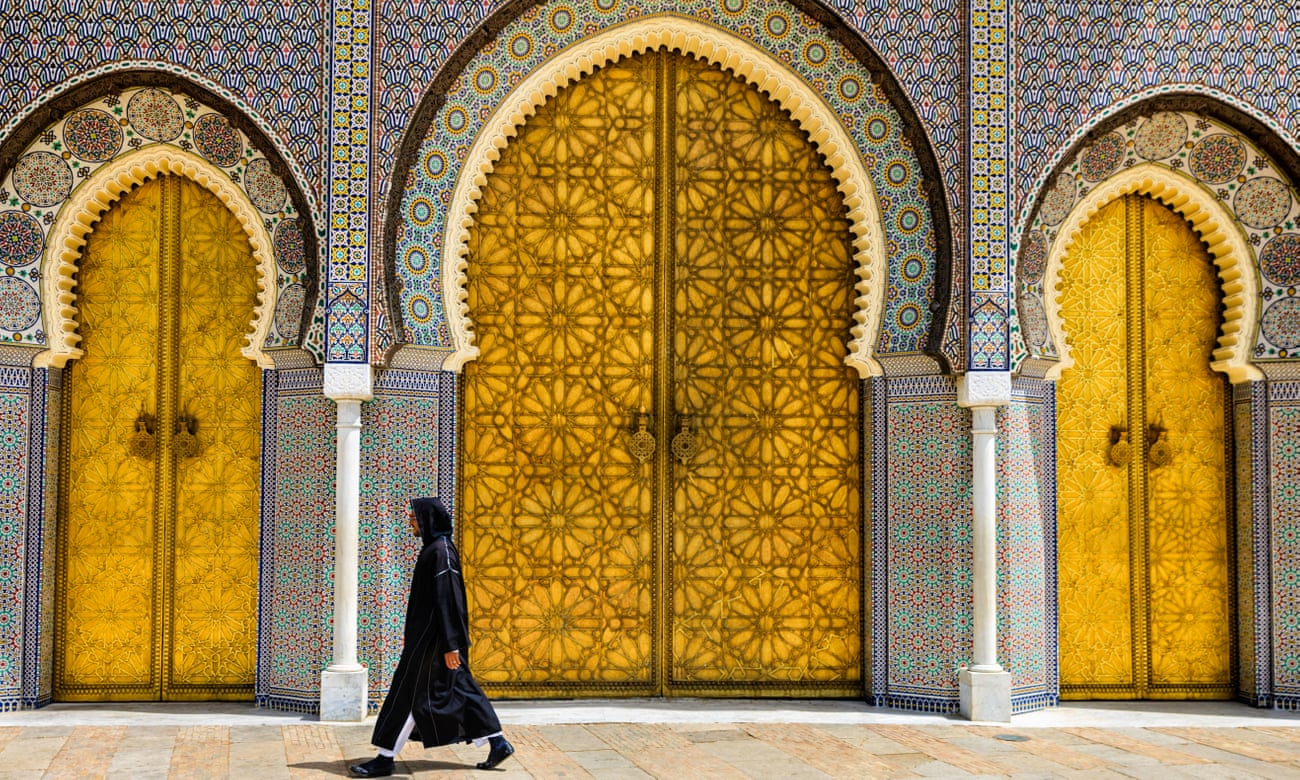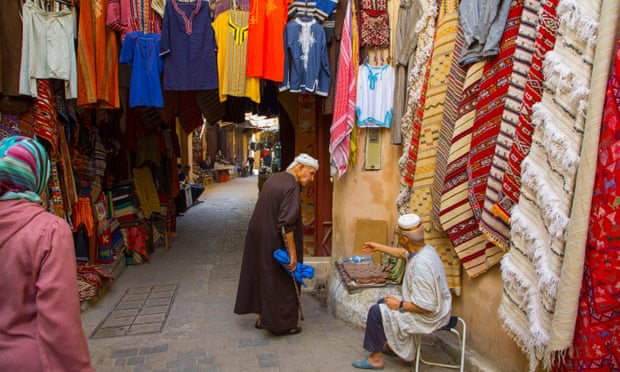The Guardian
Emma Cook
Rocking the casbah … the Royal Palace, Fez. Photograph: Getty Images
It happens on the third day, after our bookbinding class, having spent the morning deep in concentration learning how to Coptic-stitch and emboss our own leather journal.
Within minutes of leaving the attic studio, deep in the heart of Fez’s sprawling medina, we become hopelessly and unavoidably lost. Was it the alleyway to the left of the stall piled high with spices and fresh figs? Or the other one that opens into a market square with stacks of dried fruit and couscous, cages of live chickens, rugs and candy-coloured lanterns, pottery and beaten copper plates?
My teenage daughter strides ahead, weaving expertly through the shoppers, past the odd mule weighed down with wares. She turns around to grin at me every so often, liberated by the fact that this is the first time we’ve been inside the medina without a guide. She turns sharply left, then right, then left again. We wander down a maze of dark passageways that are narrower than before, stained blue walls with no windows, studded here and there with heavy oak doors. One is open and we peer into a concealed inner courtyard shaded with fig trees and paved with intricate mosaics dating back centuries.
Skin deep: the vast tanneries of Fez, built in the 16th century. Photograph: Konstantin Kalishko/Alamy
What makes Fez medina so unique is not just how large it is – more than 8km of city walls encircle the 200,000 living here – but that it is also one of the largest car-free zones in the world. Even a Mini would struggle to fit through the maze of passageways. Built in the 9th century, it was designed with five elements in each area: a mosque, a steam bath, a Qur’an school, a fountain and a bread oven. No wonder we’re finding it challenging to get back to our hotel. There are no markings or street names, no maps and no GPS signal. There’s just you, 9,000 unnamed alleys, 40,000 dead ends and your sense of direction to guide you.
I quickly discover that smell can be a more effective way to orientate yourself than a sense of direction. Down one alleyway I recognise the heady and pungent aroma of the tanneries Chouwara, probably the most memorable sight in the medina, and I know that our hotel is located nearby. Leather skins lie on the roofs, drying in the sun and men expertly step in and out of the circular vats of dye: turmeric yellow, indigo blue and poppy red. The techniques here have barely changed since it was built in the 16th century when Fez replaced Córdoba as the centre of leather production. Along with the tanners, there are craftsmen everywhere you look: tailors, shoemakers, blacksmiths and carpenters creating everything from embroidered wedding dresses to ornately carved funeral caskets.
Spice of life: learning to cook a vegetable tagine. Photograph: Omar Chennafi
It’s difficult to think of anywhere else you could fly to in less than three hours from Gatwick that would take you so far back in time, and so quickly: pre-technology, pre-globalisation and certainly pre-mass tourism. Which means, as we lose ourself in the crowds, and I let go of my fear of “being lost”, the real charm of this medina takes hold. Unlike almost every market, from Marrakech to Portobello, Fez doesn’t rely on tourists. This may change now that you can fly direct, but for the moment the stall holders aren’t angling for your money. They are pleased when you buy something, but no one is pushy because it’s a market that caters for its close-knit community that has been here for 850 years.
When we do finally get our bearings, it is sound rather than smell that guides us. We stop for tea – an infusion of geranium, verbena and mint – listening to the frenetic hammering of coppersmiths in Seffarine Square, where craftsman pound copper outside their workshops, selling anything from incense burners, teapots and couscous steamers to samovars. We also try a bowl of bissara at a small kiosk – a delicious local favourite of broad bean soup, served with olive oil and chilli.
Down another tiny alleyway a sign tells us that, finally, we have made it back to base. Behind a pair of ancient studded doors lies Palais Amani, a riad dating back to the 17th century, but re-built in the 1920s and recently renovated by the owners, wife and husband Jemima Mann-Baha and Abdelali Baha. Originally, the couple lived in London, but they had always wanted to move back to where Abdelali was born and open a hotel.
‘There’s just you, 9,000 unnamed alleys, 40,000 dead ends and your sense of direction to guide you’: entering the souk.
‘There’s just you, 9,000 unnamed alleys, 40,000 dead ends and your sense of direction to guide you’: entering the souk. Photograph: Jeronimo Alba/Alamy
After a lengthy search, they fell in love with Amani. Originally owned by a merchant family, it’s a sprawling palace that had fallen into disrepair. Now every detail has been beautifully restored, from the art deco tiling in gold and azure, to the 18 individually decorated bedroom suites – ours was Morocco meets the Jazz Age with black and white tiles, mahogany and chrome fittings. There’s a lounge bar on the roof terrace, but the heart of the hotel is the ornate courtyard full of lemon trees under which you can enjoy a pomegranate mojito.
It’s also where we eat breakfast each morning, a spread of figs and olives, flatbreads, honey and preserves. Then comes the mid-morning dilemma: another exploration of the medina or relaxing in Amani’s luxurious underground hamam, massaged with argan oil and scrubbed with rosewater and bran? For supper, we venture out again.
Back at base: Palais Amani’s garden reception area.
Back at base: Palais Amani’s garden reception area. Photograph: Palais Amani Hotel
Dar Roumana, a nearby restaurant, is a plush affair, Paris meets Morocco in decor and menu. In a tiled courtyard open to the sky, we listen to Louis Armstrong and enjoy plates of gnocchi. Clock Cafe, high up above the city, is cheaper and quirkier – run by a Yorkshireman who used to be a maître d’ at the Wolseley. There’s an eclectic mix on the menu: pancakes, Berber eggs, burgers, apple crumble and their special camel burger.
Amani also offers cookery classes and on our last morning, my daughter and I spend a couple of hours preparing a vegetarian tagine. Our workshop starts with a final trip to the souk to buy fresh ingredients then it’s back to the outdoor kitchen where we grate tomatoes and garlic and char aubergines over an open flame, seasoning them with coriander, cumin and paprika. For dessert we drizzle orange slices with orange blossom water, cinnamon and sugar and, an hour later, we enjoy our feast on the terrace, knowing that however well I replicate the recipe at home, it will always be missing an essential ingredient: the smell of lemon trees and the view across the ancient medina to the mountains.
Way to go
Flights from London direct to Fez with Air Arabia Maroc start at around £80 return. Doubles at Palais Amani from £144 B&B. Cookery classes including a tour of the souk and lunch cost £67 (group), £84 (private). For details on bookbinding classes in Fez go to craftdraft.org












